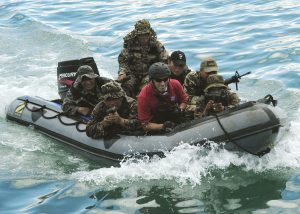Trans-Pacific View author Mercy Kuo regularly engages subject-matter experts, policy practitioners, and strategic thinkers across the globe for their diverse insights into U.S. Asia policy. This conversation with Bryan Clark – senior fellow and director of the Center for Defense Concepts and Technology at the Hudson Institute – is the 259th in “The Trans-Pacific View Insight Series.”
Briefly explain the U.S. military scenario-planning process for conventional conflict with China and Russia.
In consultation with the intelligence community, U.S. military planners identify events that should be used for planning the size and mix of U.S. forces. There is a tension, however, between planning for the most likely situations as opposed to worst-case events. For example, large-scale, high-intensity conflicts like China invading Taiwan or Russia invading Latvia would be challenging for U.S. and allied militaries but are less likely compared to scenarios such as protracted gray-zone confrontations between China or Russia and their neighbors. U.S. planners usually choose high-intensity scenarios, although protracted conflicts may be harder for the U.S. military to address.
After the scenario subjects are decided, planners build a detailed description of the events leading up to the conflict, the expected actions of adversary, allied, and noncombatant governments and militaries, and the order of battle expected to be employed by each participating nation. Scenarios usually do not detail U.S. government or military actions.
Explain the conceptual framework in designing scenarios for non-conventional conflict.
Non-conventional conflicts are those that do not involve sustained combat between regular armed forces. Examples include insurgencies by militia forces being supported by a state aggressor, such as in Ukraine; harassment of opposing government and commercial activities in international airspace or waters, as in the East and South China Seas; or a de facto blockade of a disputed territory using militia, law enforcement, and civilian forces like that around the Senkaku Islands.
The U.S. Department of Defense (DoD) plans for these events, but they are low priority. However, because they are less intense than traditional scenarios like invasions, non-conventional confrontations can be sustained longer by the aggressor and employ a wide range of proxy, civilian, and paramilitary forces that create challenges for the U.S. military. The predominance of large, highly capable units in U.S. forces makes protracted campaigns potentially unaffordable and reduces U.S. options at lower levels of escalation. As a result, the U.S. government can be portrayed as the aggressor in a non-conventional conflict because the forces it employs are disproportionate for the situation.
Identify fundamental assumptions about how the U.S. might engage in conventional and non-conventional contest with China or Russia and explain how these assumptions should be tested in scenario risk analysis.
The DoD has evolved a strong set of assumptions regarding conventional conflicts. The U.S. military generally assumes it will not be the aggressor and will have some, potentially short, warning that will allow the mobilization of forces to the conflict area. Forces already deployed respond to aggression and attempt to delay or deny the enemy’s success while preparing for the arrival of additional forces from adjacent theaters or the continental United States.
The U.S. military has a less coherent view regarding non-conventional conflict. Because these scenarios occur below the level of armed combat, U.S. military forces are often not an appropriate response, but the U.S. government does not continuously deploy law enforcement forces like the Coast Guard or paramilitary units like contractors – although Coast Guard deployments to the Western Pacific are rising. The use of conventional forces is episodic and limited to shows of force, exercises, or freedom of navigation operations rather than directly countering the non-conventional aggression.
What are key challenges and opportunities for U.S. military planners in preparing for potential military confrontation involving China or Russia?
China and Russia are difficult to plan against because they pose multidimensional challenges in areas close to their own territory. Both countries established extensive sensor networks using radar, electronic intelligence, and space imagery around their territory that can be used for surveillance and targeting of a large inventory and variety of precision ballistic and cruise missiles. Their sensor and weapon networks give China and Russia the ability to conduct rapid, large-scale attacks in regions they have interests such as the East and South China Seas for China and Eastern Europe for Russia.
In a conventional conflict, Chinese or Russian missiles give their militaries the ability to delay U.S. reinforcements while quickly attacking U.S. allies to coerce them into submission. In a non-conventional conflict, China and Russia can threaten U.S. military forces and force U.S. commanders to either send in small units at high risk or employ larger units that can defend themselves but are disproportionate for the non-conventional confrontation. As evidenced by the success of Chinese or Russian gray-zone operations over the last decade, the U.S. government has not determined a satisfactory non-conventional response.
How should the new U.S. administration align defense spending allocation with emerging non-conventional threats?
The U.S. government will need a larger number of units that are smaller and less expensive to buy and maintain compared to today’s U.S. military. Less heavily-armed units such as Littoral Combat Ships, Coast Guard cutters, or company-size National Guard formations would be more proportional in non-conventional confrontations against Russian-supported proxy forces or People’s Armed Forces Maritime Militia ships. These units would also be affordable enough to buy and operate in large enough numbers so they can sustain a robust presence in contested areas for a protracted periods.

































